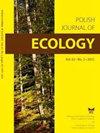日本北部城市边缘西伯利亚飞鼠的活动范围和巢安排
IF 0.7
4区 环境科学与生态学
Q4 ECOLOGY
引用次数: 2
摘要
在日本,通过城市化和开发道路和田地而造成的森林碎片化很常见;因此,西伯利亚飞鼠的数量在未来可能会减少。本研究通过澄清其栖息地和巢穴安排,考察了城市化对狼蛛的影响。从2005年到2007年,在北海道东部(日本北部)的大江户市捕获了10只飞松鼠,并对其进行了无线电遥测追踪。雄性的100%MCP(最小凸多边形)面积(平均值±SD;6.5±5.1公顷)和95%MCP面积(3.6±1.3公顷)明显大于雌性(分别为1.8±1.0公顷和1.0±0.5公顷)。此外,雄性(1.2±1.1公顷)的核心面积大于雌性(0.2±0.2公顷),尽管这一差异并不显著。雄性和雌性使用更多位于其核心区域内部而非外部的巢穴。雄性(78.6±139.9m)比雌性(39.7±39.9m)从核心区边缘到核心外巢穴的距离更长,但这一差异并不显著。城市森林中的西伯利亚飞松鼠可能与连续森林中的飞松鼠表现出相似的生态;然而,由于城市森林限制了巢穴和食物资源,它们可能会改变自己的行为,与他人共享资源。本文章由计算机程序翻译,如有差异,请以英文原文为准。
Home Range and Nest Arrangement of the Siberian Flying Squirrel Pteromys volans in an Urban Edge, Northern Japan
ABSTRACT Forest fragmentation by urbanizing and developing roads and fields is common in Japan; thus, the Siberian flying squirrel (Pteromys volans) population may decrease in the future. This study examined the effects of urbanization on P. volans by clarifying their home ranges and nest arrangements. Ten flying squirrels were captured and radio-telemetrically tracked from 2005 to 2007 in Obihiro City in eastern Hokkaido (Northern Japan). Males had significantly larger 100% MCP (minimum convex polygon) areas (mean ± SD; 6.5 ± 5.1 ha) and 95% MCP areas (3.6 ± 1.3 ha) than females (1.8 ± 1.0 ha and 1.0 ± 0.5 ha, respectively). Also the core area of males (1.2 ± 1.1 ha) was larger than females (0.2 ± 0.2 ha), though this difference was not significant. Males and females used more nests located inside than outside of their core areas. Distance from the core area edge to the nest located outside the core was longer for males (78.6 ± 139.9 m) than for females (39.7 ± 39.9 m), but this difference was not significant. Siberian flying squirrels in urban forests likely show similar ecology with flying squirrels in consecutive forests; however, they might change their behavior to share resources with others because urban forests restrict nest and food resources.
求助全文
通过发布文献求助,成功后即可免费获取论文全文。
去求助
来源期刊

Polish Journal of Ecology
环境科学-生态学
CiteScore
1.10
自引率
0.00%
发文量
9
审稿时长
18-36 weeks
期刊介绍:
POLISH JOURNAL OF ECOLOGY (formerly Ekologia polska) publishes original scientific research papers dealing with all aspects of ecology: both fundamental and applied, physiological ecology, evolutionary ecology, ecology of population, community, ecosystem, landscape as well as global ecology. There is no bias regarding taxons, ecosystems or geographical regions.
 求助内容:
求助内容: 应助结果提醒方式:
应助结果提醒方式:


